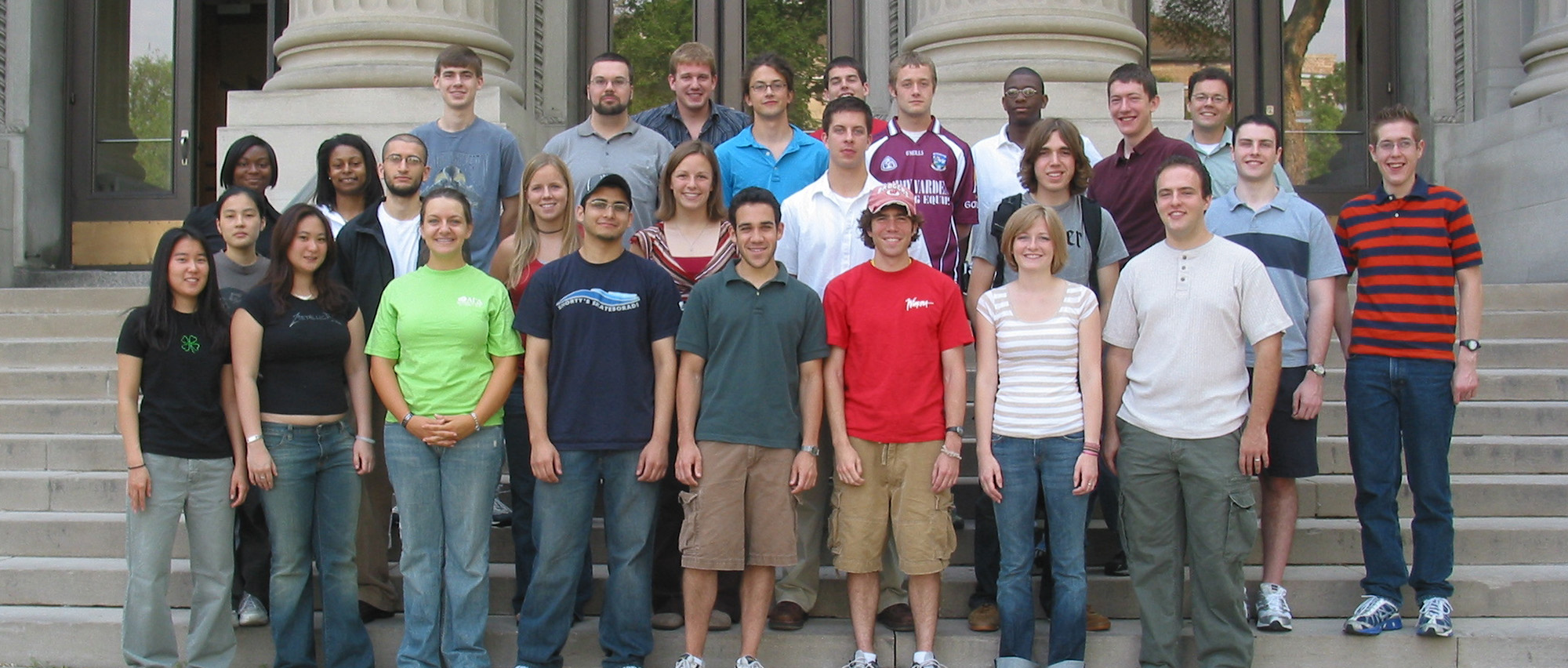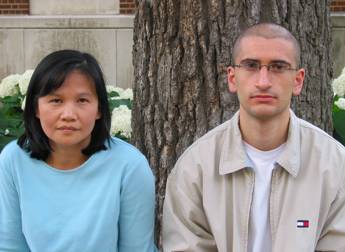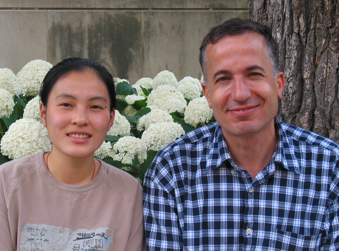

Home Institution: Winona State University
Major/Minor: Chemistry and Mathematics
MRSEC Mentor: R. Lee Penn
The Effect of Ionic Solutions on Titanium Dioxide Nanoparticles
Titanium dioxide, or Titania, has three different polymorphs: Anatase, brookite, and rutile. A sol-gel synthesis resulted in the formation of anatase and brookite at different ratios. It is unclear when ionic strength of the suspension is most critical, the synthesis or aging process. TiO2 nanoparticles were aged in NaNO3 and NaCl ionic solutions with concentrations ranging from 0.01-1.0M. X-Ray Diffraction systematically calculated the ratios of polymorphs, as well as the particle size by a Rietveld Refinement method. TEM verified the polymorph ratios as well as confirmed particle size, growth mechanism, atomic structure, and crystallography. Results show that increasing the concentration of ionic solutions during the hydrothermal aging step had no effect on the ratios of anatase to brookite. The presence of ionic solutions during synthesis is more critical than during the hydrothermal aging process.

Home Institution: Cornell University
Major/Minor: Materials Science and Engineering
MRSEC Mentor: Frank Bates
Investigations of the Morphological Behavior of Poly(lactide)-b-poly(styrene)-b-poly(isoprene)-b-poly(styrene)-b-poly(lactide) Pentablock Copolymer
Block copolymers are useful materials because of their variable mechanical, chemical and structural properties. Capable of forming self-assembling network morphologies, such as core-centered gyroid and recently the discovered O-70 phase, it is feasible that when one of the domains is removed the copolymer will become nanoporous. One material that may exhibit these properties is the poly(lactide)-b-poly(styrene)-poly(isoprene)-b-poly(styrene)-b-poly(lactide) [LSISL] pentablock copolymer. This material is thought to be mechanically robust from a combination of the glass-like styrene block and the rubber-like isoprene block in conjunction with the pentablock structure that immobilizes the polymer chain ends. If the [LSISL] copolymer forms network, removal of the lactide blocks on both ends could provide a pathway that allows for transport of small molecules, making it a candidate for membrane applications.

Home Institution: University of Massachusetts — Amherst
Major/Minor: Chemical Engineering
MRSEC Mentor: Chris Macosko
Effects of Polyethylene Naphthalate-Clay Nanocomposites on Young's Modulus and Coefficient of Thermal Expansion
Mixing a clay nanocomposite or filler with a polymer can increase the mechanical properties, such as: Youngís modulus and coefficient of thermal expansion (CTE). The polymer of that we will be trying to increase the mechanical properties of is polyethylene naphthlate (PEN); PENís industrial application is in the data storage industry, in the form of magnetic tape. The samples of PEN-clay nanocomposites will be made through melt intercalation by a small scale extruder. After the samples have been made we will begin measuring the Youngís modulus, CTE, and degree of crystallinity. The goal is to find which type of clay yields the highest Youngís modulus and lowest thermal expansion coefficient.

Home Institution: University of Pittsburgh
Major/Minor: Material Science and Engineering/Philosophy
MRSEC Mentor: Chris Leighton
Ferro/AntiFerro Coupling and Exchange Bias of Co/FeMn and Fe/Cr
The coupling of Ferromagnetic and Antiferromagetnic materials in thin films has lead to novel spin interactions and exchange bias that can be exploited for memory storage and other applications. In this project, the FM/AFM materials Fe/Cr and Co/FeMn are studied for their underlying mechanisms and physics. The main goal at this stage was producing clean surfaces on the materials to allow for better viewing of these base mechanisms and to eliminate extraneous surface interactions.

Home Institution: University of Northern Iowa
Major/Minor: Chemistry
MRSEC Mentor: Xiaoyang Zhu
Charge Carrying Species of PTCDI-C8 when used as a Semiconductor Material in a FET
The goal of this project is to create an apparatus that can fabricate a polymer FET on a silicon waveguide and analyze its operation in situ. An infrared radiation beam is projected into the waveguide and evanescent waves penetrate into the substrate of the polymer FET. These waves can be detected and analyzed by an FT-IR in the same way as normal IR waves. This method allows the potential charge carrying species of the polymer, PTCDI-C8, to be examined while the polymer FET is operation. The low permeability of the evanescent waves (~1 micron) necessitates a balance between dielectric thickness and IR signal strength. A side project will investigate the use of a nanolayer technique to create a very thin dielectric layer.

Home Institution: Washington State University
Major/Minor: Materials Science and Engineering
MRSEC Mentor: Michael Tsapatsis
Optimizing the Swelling Procedure for a Layered Silicate
Zeolites are micro porous crystalline framework materials with many applications including catalysts, absorbents, and ion exchangers. Recently a material composed of many flat stacked zeolite layers has been synthesized. For several applications, it would be beneficial for the layers to be separated thus increasing the surface area and decreasing the time for molecules to pass through the pores. In order to separate the layers the crystal will undergo a process known as swelling. The swelling will occur when the layer spacing is increased by organic molecules. A procedure was created to perform the swelling of similar layered crystals. To improve upon this, systematic variations of the procedure will be performed to further improve the swelling technique. X-ray diffraction and Scanning Electron Microscopy analysis will be used to characterize the material.

Home Institution: Carleton College
Major/Minor: Physics
MRSEC Mentor: Lorraine Francis
Correlations Between Hardness and MFFT and CPVC of Latex/Ceramic Composite Coatings
The goal of this research is to further investigate the correlation between hardness of polyvinyl acetate (PVAc)/alumina composite coatings with the Minimum Film Formation Temperature (MFFT) and Critical Pigment Volume Concentration (CPVC). Based on research conducted by Ming Lei et al. (2003), the hardness of the composite coatings should experience significant increase at the MFFT and CPVC. By using methods and techniques from Leiís masterís thesis, it should be possible to use nanoindentation, as opposed to Vickersí hardness testing, to investigate the characteristics of the coatings. The poor correlation between the data from the Vickersí and nanoindentation tests are likely not results of the misunderstanding of film formation and microstructure, but rather are caused by the differences between the characterization instruments themselves.

Home Institution: Georgia Institute of Technology
Major/Minor: Chemical and Biomolecular Engineering/Spanish
MRSEC Mentor: Efie Kokkoli
Application of PEGylated "Stealth" Liposomes to Targeted Drug Delivery in Cancer Cells
In bioengineering, liposome-based drug delivery aids are being explored for their effectiveness in facilitating the delivery of drugs that treat cancer. Liposomes are generally described in terms of their phospholipid bilayers, which form vesicles into which a cell-killing drug can be inserted. When endocytosed by a cancer cell, the liposome can then decompose to allow for the release of the drug. With liposomic drug carriers, drugs can target specific cells. It is proposed that one way this targeting can be accomplished is by attaching to the liposome peptide-amphiphiles that will bind to a specific integrin expressed on the cancer cell. We use a peptide-amphiphile that we call PR_b, which binds to the integrin a5b1 through the binding sequence RGD. The PEG coating on the liposome surface forms a steric barrier and allows the liposome to extend its circulatory life.
Our experiment aims to test several variables to find the best traits for a drug-delivering liposome. Each liposome tested differs from the others by either surface area percentage of PR_b, surface area percentage of PEG, or PEG length (MW). Liposomes containing a fluorescent tag will incubate with one of two cell lines, temperatures, and durations. After incubation, analysis through flow cytometry will correlate the degree of binding with fluorescent intensity. Ideally, this experiment will lead to further exploration into the factors that favor targeted drug delivery.

Home Institution: Truman State University
Major/Minor: Chemistry/French
MRSEC Mentor: Kent Mann
Synthesis and Characterization of Pyrene-Capped Oligothiophenes for Use as Organic Semiconductors
Organic semiconductors offer cheaper manufacturing alternatives to silicon-based materials due to their mechanical flexibility and processibility. Oligothiophenes show promising characteristics needed to produce efficient semiconductors. X-ray crystallography demonstrates several close intermolecular contacts make oligothiophenes with aromatic capping groups good candidates for organic semiconductors. This research will explore the effects of capping oligothiophenes with pyrene groups. Previous work has shown that mobility improves with increasing either the number of thiophene rings in the oligomer or the number of aromatic rings on the capping groups. This goal of this research in synthesizing pyrene-capped oligothiophenes is a step in both directions. Successful syntheses were confirmed by 1H NMR, cyclic voltammetry, and UV-Vis spectroscopy.

Home Institution: University of Minnesota
Major/Minor: Chemistry
MRSEC Mentor: Mark Distefano
Design, Synthesis, and Biological Applications of DATFP Containing FPP Analogues With Enhanced Stability
Protein prenylation is a post-translational modification involving the addition of either a 15 or 20 group to the cysteine residue of a protein. Prenylated proteins are of great interest because they are involved in numerous biological activities including the development of cancer. Photoaffinty labeling is a useful method for determining specific binding sites. This is done by irradiating the photoaffinity labeled compound which forms cross links with nearby residues. The specific amino acids active in binding events may then be determined. The purpose of my research is to synthesize a dihydro geranyl pyrophosphate (GPP) with a diazotrifluoropropionyloxide (DATFP) photolabel. Previous experiments using DATFP-geranyl-pyrophosphate which contains a double bond at the C-6 carbon. DATFP-dihydro-GPP, which lacks the C-6 double bond, is expected to be more stable.

Home Institution: Cornell University
Major/Minor: Chemical and Biomolecular Engineering
MRSEC Mentor: Tim Lodge
Dependence of Critical Micelle Temperature on Polydispersity in Dilution Solutions of Diblock Copolymers
Diblock copolymers are hybrid materials consisting of two distinct polymer species covalently bounded at one end. When a block polymer is dispersed into a selective solvent, meaning that the solvent has a higher affinity for one of the polymer species over the other, the polymers self-assemble into nanostructures called micelles. However, this behavior is temperature-dependent. When the system reaches the ìcritical micelle temperatureî, or CMT, the micelles become entropically unfavorable, and they break up into linear copolymers suspended in the solvent. In this study, we will investigate the CMTs of dilute solutions of polystyrene-b-polyisoprene (PS-PI) diblock copolymers, in the regime where we can assume very little interactions take place between the micelles. The PS-PI diblock samples are synthesized using a chain-growth polymerization mechanism called ìliving anionic polymerizationî to have different polydispersities, i.e., different distributions of molecular weights. We will determine the CMTs of these PS-PI diblock samples by dynamic light scattering, from which we can monitor the size of the micelle aggregates formed in solution and pinpoint the temperature at which the micelles break down We hypothesize that the polydispersities of these diblock copolymers will alter their CMTs.

Home Institution: University of Alabama
Major/Minor: Chemical Engineering
MRSEC Mentor: C. Daniel Frisbie
Fabrication, Characterization, and Testing of an Alq3/NPB Organic Light-Emitting Diode
Organic light-emitting diodes (OLEDs) have shown significant promise due to being brighter and using less power than traditional inorganic LEDs. To date, several companies have incorporated OLEDs into displays for consumer electronics. Typically, OLEDs incorporate at least two organic semiconductor layers; our objective to fabricate an OLED using Alq3 [Tris (8-Hydroxyquinoline) aluminum] as the emissive layer and NPB [6-Naphthylphenylbenzidine] as the hole-conducting layer. Thin films of these organic compounds were deposited onto a transparent electrode using vacuum thermal evaporation. Both optical microscopy and atomic force microscopy were used to characterize the organic surfaces. Finally, we applied a voltage to the deviceís electrodes to test its light-emitting capabilities. Results from all three stages have given us insight into the optimal design and fabrication techniques for these devices.

Home Institution: Simmons College
Major/Minor: Biochemistry and Mathematics
MRSEC Mentor: Victor Barocas
Protein Crystal Growth of Triclinic Lysozyme in the Magnetic Field
Lysozyme can be crystallized in four different space groups: monoclinic, triclinic, orthorhombic, and tetragonal. The optimal growth conditions of triclinic lysozyme have not been determined and were investigated initially. Lysozyme crystals were grown in varying concentrations of precipitant, buffer, and protein. Once single crystals were obtained, they were diffracted in order to determine which concentrations produce the triclinic space group. The conditions that produced the highest quality and greatest volume of these crystals were then tested in a 9.4 Tesla magnet. The magnetic field facilitates the orientation of the macromolecule, thus larger crystals of higher purity grow. The magnetic field allows for more control over crystal growth and produces an ideal crystal for diffraction.

Home Institution: Gustavus Adolphus College
Major/Minor: Chemistry
MRSEC Mentor: Kent Mann
Synthesis and Characterization of Anthracene -capped Oligothiophenes for use in Thin-Film Transistors
Crystalline organic semiconductors may provide a cheaper alternative to silicon-based thin film transistors. To date, however, there has yet to be synthesized an organic material that can compare favorably to siliconís conduction capabilities. Past research has shown that oligothiophenes are promising precursors to a slew of synthetic molecules capable of conducting charge in a thin film transistor. The purpose of this project is to synthesize anthracene-capped terthiophene using a Stille coupling method, characterize it using NMR, and cyclic voltammetry, and compare its electrical properties to previously synthesized terthiophene analogues as well as anthracene-capped bithiophene. Also, Anthracene-capped 3,3í dihexyl bithiophene wazs synthesized to improve the solubility of Anthracene-capped bithiophene, to allow for easier characterization. The expected results will show that the terthiophene analogue facilitates improved mobility over anthracene-capped bithiophene.

Home Institution: Howard University
Major/Minor: Biology/Chemistry
MRSEC Mentor: Chun Wang
Synthesis and Characterization of Anthracene -capped Oligothiophenes for use in Thin-Film Transistors
Hyaluronan is a very important biomaterial which can be found mostly in the extracellular matrices, in the vitreous of the eye as well as in the sinovial joints. Its viscous hyrdophilic solutions possess high lubricity and also exhibit good shear properties. We are interested in producing a more robust form of this gel which will later be used in various tissue engineering and therapeutic applications. For this study, HA is modified with pendant amines (HA-NH2) through a carbodiimide-mediated reaction and further reacted with N-succinimidyl 3-(2-pyridyldithio)-propionate (SPDP). HA-PD, the resulting compound, can udergo various chemistries for modification and cross-linking. For this project, a disulfide exchange between the HA-PD and a molecule with free thiols will be performed to create a cross-linked hydrogel network. These modifications and cross-linking methods wil be used to create hydrogels. Equilibrium and dynamic swelling experiments will then be performed to characterize these hydrogels.

Home Institution: University of Alabama
Major/Minor: Chemical Engineering
MRSEC Mentor: C. Daniel Frisbie
There has been a growing interest in the properties of mixed-phase materials consisting of hydrogenated amorphous silicon containing silicon nanocrystalline inclusions (a/nc-Si:H). Recent results suggest that these a/nc-Si:H films may possess superior electronic characteristics for photovoltaic applications. Prof. U. Kortshagen in the Dept. of Mechanical Engineering at the University of Minnesota has recently developed a dual chamber Plasma Enhanced Chemical Vapor Deposition system, whereby silicon nanocrsytals are produced in one plasma system, which are then injected into a second plasma chamber, where a-Si:H is co-deposited using a silane plasma. This Co-Deposition system provides enhanced control over the nanocrystalline concentration (nanocrystal diameter of roughly 3-5 nm) while separately enabling the growth of a high quality amorphous silicon matrix. Kakaliosí lab has recently observed that these a/nc-Si:H films can display a non-trivial non-Ohmic current-voltage characteristic, where the deviation from Ohmís law depends on the temperature and nanocrystalline concentration of the thin film mixed phase material.

Home Institution: University of Minnesota — Morris
Major/Minor: Chemistry/Mathematics and Physics
MRSEC Mentor: C. Daniel Frisbie
Fabrication and Characterization of Organic Thin Film Transistors (OTFTs)
There is a need to develop air stable organic semiconducting devices while also considering key performance parameters such as: on-to-off current ratio, field effect mobility, and threshold voltage. This research will focus on the fabrication and characterization of new p-channel OTFTs based on pentacene and novel thiophene-acene hybrid molecules. Highly crystalline thin films will be deposited from the vapor phase onto various gate/insulator substrates followed by deposition of metal electrodes. Thin film structure and morphology will be examined using X-ray diffraction and atomic force microscopy. The electrical properties of OTFTs will be observed using a top-contact transistor geometry and probe station. The connection between molecular/crystal structures and electronic properties provides a foundation for elucidating structure-property relationships and facilitates development of new organic semiconductors with enhanced transport properties.

Home Institution: California Polytechnic State University
Major/Minor: Mechanical Engineering
MRSEC Mentor: Jeff Roberts
Oxidation Kinetics of Silicon Nanoparticles
Silicon nanoparticles are an important technology to develop because of silicon's low toxicity, high stability, and excellent semiconducting properties. Silicon is a reactive element that readily oxidizes in air. When silicon oxidizes, the crystalline particle core shrinks while the amorphous silicon dioxide on the outer layer of the particle grows. The differing size of the nanoparticles will alter the quantum confinement effects, such as light emission. Our study will focus on these particle changes. Fourier-transform infrared (FTIR) spectroscopy will be used to monitor native oxide formation on silicon nanoparticles. RF plasma will be used to generate silicon nanoparticles from silane gas. Particles will be subjected to wet and dry oxidation conditions after being subjected to temperatures ranging from 23 to 700 degrees Celsius.

Home Institution: North Dakota State University
Major/Minor: Electrical Engineering
MRSEC Mentor: Allen Goldman
Effect of Annealing on the Characteristics of Gold Nanowires
The objective of this research project is to study the effect of annealing on the characteristics of gold nanowires. As gold nanowires are annealed past temperatures of 150 degC, they begin to break up into gold nanoparticles. Once in the form of nanoparticles, we aim to try to find the opportune temperature and length of time that the nanowires should anneal to give us similar-sized nanoparticles, and small gap widths between particles. After each trial, we will perform a statistical analysis of the width of the nanoparticles, and the gap width between nanoparticles. We then propose to test the transport and tunneling ability of these nanoparticles. Nanoparticles have many applications in lasers, optical detectors, white light sources, quantum computing, and solution-based for medical research. In characterizing nanoparticles, we can better understand the effects they may have on all of these useful applications. SEM and AFM analysis will be used.

Home Institution: University of Connecticut
Major/Minor: Chemistry and Molecular Cell Biology
MRSEC Mentor: Frank Bates
The Effect of Curing Agents on Block Copolymer Modified Epoxies
Self-assembling amphiphlic block copolymers can be used in a number of applications ranging from soaps and surfactants to vesicles in drug delivery. The ability to control the equilibrium morphologies of these polymers is an attractive feature in the aforementioned areas and has lead to extensive study. Recently, self-assembling block copolymers have been used to toughen epoxy thermosets. In this particular study, we are studying a three component epoxy system where the three components are the block copolymer, epoxy resin and the curing agent used to strengthen the resin cure. The epoxy and block copolymer will remain constant and the effect of varying curing agents will be evaluated.

Home Institution: University of Wisconsin — Eau Claire
Major/Minor: Chemistry/Geology
MRSEC Mentor: C. Daniel Frisbie
Synthesis and Photovoltaic Application of Polythiophenes
Poly-(3-hexylthiophene) or P3HT is known to be a semiconductor that exhibits good behavior relative to other organic semiconductors, especially in the realm of organic based photovoltaic cells. However, it has limited potential for use due to the fact that it will degrade when exposed to air, so it must be fabricated in an inert gas environment. The allure behind organic based semiconductors is that they have the potential to be far less expensive than the typical Silicon or other inorganic semiconductors. This is mainly due to the simplicity that is associated with their production. PQT-12, a poly-(3,3ííí-dialkyl-quaterthiophene), has exhibited very good behavior compared to P3HT under normal atmospheric conditions, but has yet to be used in the photovoltaic realm.

Home Institution: University of Iowa
Major/Minor: Chemical Engineering
MRSEC Mentor: Michael Tsapatsis
AlPO4-5 Thin Film Zeolite Synthesis and Characterization
A zeolite is an inorganic crystalline material with a porous framework. Zeolites can be made from several different inorganic materials and can have different crystallographic features. Highly ordered zeolites can have numerous applications including: membrane separation, adsorption, and catalysis. One application of interest is to use AlPO4-5 zeolites as hosts for nanostructures and for gas and vapor separation. These applications take advantage of the 7.3 angstrom pore in the AlPO4-5 crystal. To be an effective host or membrane, the zeolite needs to have a highly ordered structure with the pores perpendicular to a substrate.AlPO4-5 crystals can be synthesized on a silicon substrate. By using a functionalized silicon substrate which is then seeded with AlPO4-5 crystal seeds, highly ordered crystals can be grown. Seeding the substrate enhances orientation of the crystals in the desired direction. The crystals then undergo a secondary growth phase that allows for the extension of the crystals. After undergoing the hydrothermal growth, the samples are characterized with Scanning Electron Microscopy (SEM) and X-ray Diffraction (XRD). SEM allows for the orientation and amount of growth of the crystals to be observed. XRD is used to measure the orientation of the crystals over the substrate. The diffraction of x-rays is used to determine crystallographic orientation over the sample. Experimentation with different synthesis methods will allow for highly ordered crystals with the desired orientation to be synthesized.

Home Institution: Penn State University
MRSEC Mentor: Frank W. Snowden
Investigation on Thermal and Electrochemical Properties of Some Organic Semiconductors
Differential scanning calorimetry (DSC) and thermogravimetric analysis (TGA) were used along with cyclic voltammetry (CV) to investigate the thermal and electrochemical properties of several oligothiophenes, and oligoacenes and some of their derivatives. Thermal stability as well as sublimation temperatures, and crystals and thin films are important factors in this area of research. Cyclic voltammetry provides oxidation/reduction potentials of the compounds which can be used as a predictor of how well they will behave as semiconductors.

Home Institution: Jackson State University
MRSEC Mentor: Uwe Kortshagen
Self-assembly of Germanium Nanoparticles
Recently, there are interests in studying Germanium (Ge) nanoparticles to provide efficient solar cells. Rather than using silicon nanoparticles, Ge has better absorbencies in the near IR and Visible spectra. In order for the Ge to have good conductivity, quantum confinement, and crystallinity properties, the surface of Ge can be modified using selected monomers. My interest is adhering propionic acid (PA) onto the Ge surface to increase interactive sites for self-assemblies and to provide interfaces between lattices. By using the carboxylic acids as functional groups on the Ge nanoparticles, the hydrophilic interaction would oxidize the Ge surface and disperse modified Ge nanoparticles throughout the solvent. These particles will be characterized by TEM.

Home Institution: Penn State University
MRSEC Mentor: C. Daniel Frisbie
Synthesis and Solid State Structures of New Organic Semiconductors
My summer research plan includes the synthesis of new organic semiconductors using Knoevenagel condensation reactions of aromatic quinones with malononitrile. Based on previous experience in our group these targeted molecules are expected to have unique solid state structures and electrical properties conducive for favorable application as organic semiconductors. For instance we anticipate that the resulting materials would have low band gap, and form pi stacks with short intermolecular distances in the solid state.

Home Institution: University of St. Thomas
MRSEC Mentor: C. Daniel Frisbie
In situ Self-assembly of a G-DNA Molecular Scaffold on Mica Using a Polymeric Template
Research on the structure and function of guanine rich nucleic acids has shown that multiple guanine repeats in a sequence enable these biopolymers to adopt a quadruple helical structure generally known as G-DNA. In the work described here, the DNA oligomer GGGGTTGGGG (Tet1.5) is used to create a self-assembling linear supramolecular structure termed a G-wire. The ability to grow G-wires on a substrate could be employed to make connections between nanoscale devices. Currently, the polymer poly-5-norbornene-2-carboxylic acid (D.P. 4000) with the amine-linked oligonucleotide GGGGTTGGGG at a frequency of 1 oligonucleotide to 10 carboxylic acid groups has been synthesized to serve as a rigid backbone for the self-assembly of G-wires. Atomic Force Microscopy is used to characterize polymer-templated self-assembly of G-wires on a mica substrate.

Home Institution: SPAN High School
MRSEC Mentor: Efie Kokkoli

Home Institution: Lincoln International High School
MRSEC Mentor: Chris Palmstrom
Shape Memory Effect
Shape memory involves physical changes in a solid that may or may not be obvious to the naked eye. It involves the "remembrance" of the original shape of the material since shape is a property that matter (a material) has. A shape-memory material is one that undergoes a change of crystal structure at a certain temperature called the transformation temperature. Above this temperature the material has one crystal structure (cubic in the case of Cu-Al- Ni) and below this temperature it has another (orthorhombic for Cu-Al- Ni). The low temperature structure of these types of materials allows the material to be easily and apparently permanently deformed. However on heating the material returns to its high temperature structure which has only one possible shape. Thus the material has "remembered" its shape. The high school curriculum designed begins with the basic properties of matter. Students will learn about physical properties of materials and they relate to memory effects in materials. Students can then use the knowledge they have gained to explore and develop uses for memory materials.

Home Institution: Columbia Heights High School
MRSEC Mentor: Dan Dahlberg
Magnetic Domains and Domain Walls: A Curriculum for High School
Magnetic storage mediums are the most common form of rewritable data storage on the market today. Every personal computer uses magnetic media for mass storage, and this is an interesting and engaging topic that students can understand in a fairly qualitative way without needing a rigorous mathematical understanding. The goal of this curriculum is to develop students' sense of magnetic domains and their importance in materials science while avoiding the mathematical descriptions that are beyond the scope of a high school physical science course. To achieve that this series of lessons begins with an introduction to magnetic forces and fields and proceeds to develop a strong qualitative understanding of magnetic domains through a simple mental model and visualizations using bitter patterns to see magnetic domains in common magnetic media.

Home Institution: Afrocentric Educational Academy
MRSEC Mentor: Michael Tsapatsis
Properties of Matter
This program is designed to help eighth grade students become involved with internet research applications in the field of material science. This program gives students a selection of internet (safe) websites that they can navigate to research their project. This program also aligns students with the University of Minnesota, and U of M research scientists who are able to talk with and aid students in their research. This project addresses the key Minnesota State Standards for an introductory chemistry course. This also advances the core curriculum of the Minneapolis Public Schools.

Home Institution: Edison High School
MRSEC Mentor: Kevin Dorfman
Polydimethylsiloxane (PDMS) molds for studying Physical and Chemical Changes in Microchannels
Physical and chemical changes are treated at the beginning of any basic chemistry course. Small scale experiments are being introduced to conserve materials and minimize wastes. Through the use of technology used to create microchannels in PDMS, students have the opportunity to design and study the effects of different channel configurations on mixing, diffusion, and rates of chemical reactions. The use of PDMS offers an inexpensive and robust inquiry-based laboratory experience for students. Additionally, PDMS can be treated and used to show differences in hydrophobicity and the effect of catalyst concentration on material properties. Additionally, PDMS and other similar materials can be compared for biocompatibility.

Home Institution: Minneapolis South High School
MRSEC Mentor: C. Daniel Frisbie
UMN MRSEC
435 Amundson Hall, 421 Washington Ave. SE, Minneapolis, MN, 55455
P: 612-626-0713 | F: 612-626-7805